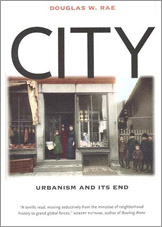Book Review
City: Urbanism and Its End
By Douglas W. Rae. New Haven, CT: Yale University Press, 2003; xix + 516pp., illustrations, maps; cloth $35.00; paper $20.00.
 |
After decades of analysis, the story of the rise and decline of American industrial cities is well known. Works like Sam Bass Warner's The Private City: Philadelphia in Three Periods of Its Growth (1968), Arnold Hirsch's Making the Second Ghetto: Race and Housing in Chicago, 1940-1960 (1983), Jon Teaford's The Rough Road to Renaissance: Urban Revitalization in America, 1940-1985 (1990), Thomas Sugrue's The Origins of the Urban Crisis: Race and Inequality in Postwar Detroit (1996), and numerous others have traced the trajectory of urban industrial expansion, population growth, and technological innovation followed by suburbanization, industrial decline, population loss, and racial and economic division. Given the full shelf of urban narratives written over the past half century, what does a monograph on one midsized city—New Haven, Connecticut—bearing the bold title, City: Urbanism and Its End, have to add to our understanding?
The answer to this question is the combination of disciplinary perspective and practical application. Douglas Rae is a professor of political science and management who has worked in New Haven's municipal government. From this vantage point, he turns our attention to his home city to ask who has wielded the power there over the last century. The answer, he argues throughout a rich and rewarding narrative, is complex and inseparable from the cultural and social life of the city's streets. It is the combination of Rae's inquiry into power and his attention to the social and cultural details of New Haven that adds to our understanding of both the past lives of cities and contemporary attempts to reinvigorate the urban landscape.
What makes Rae's story interesting is his success in answering the questions of one discipline—political science—with the tools of another—history. As a political scientist, he aims to expand his discipline's picture of the forces that determine the locus of power within cities. Previous authors had asked how and by whom the power of government was exercised. Rae instead asks how and by what forces the power of government has been limited and then—given those limitations—what forces have allowed the city to function successfully in the past.
City: Urbanism and Its End is grounded in the social, cultural, and physical fabric of the city. Rae begins his narrative with a portrait of Joseph Perfetto, the owner of a small office supply store in central New Haven. Perfetto's store is a relic of a city where local economic bonds supported a great variety of small-scale enterprises from corner grocery stores to banks. Through portraits like these, Rae traces the specific economic and technological forces that fostered New Haven's economic base. Fixed rail transportation created a dense urban fabric that helped to support a city government with growing financial coffers and a gainfully employed citizenry. Business grounded in New Haven had a commitment to the well-being of the city. The combination of proximity, interdependence, and relative prosperity forced the residents to negotiate a degree of social harmony. Social institutions that arose from social proximity were the glue that held the city together. Rae calls this social and economic interdependence "urbanism." He argues that "urbanism" allowed for successful governance when New Haven was at its height.
While the city prospered financially, citizens' expectations for municipal government were limited to investments in infrastructure and services. These limited expectations constrained the government's powers and attempts to carry out grand plans, such as a City Beautiful-inspired plan in the early decades of the 20th century.
As the technological and economic underpinnings of the city came apart during the second quarter of the 20th century, this limited view of municipal government continued. The great age of urban renewal during the 1950s and 1960s had little political constituency in New Haven. The combination of land clearance, highway building, and housing projects was run by technocratic organizations that were not directly responsible to elected officials.
Since the heyday of urban renewal, Jane Jacobs has celebrated the lost texture of American urban neighborhoods. Rae makes a convincing argument that the neighborhoods that Jacobs praises were dependent on a set of factors that have almost entirely vanished except in the densest cities. The industry that remains in New Haven is now controlled by distant corporations, and there are few prospects for a revitalization of a central city industrial base. Like many post-industrial cities, New Haven's largest employers are hospitals and universities.
Given the history of urban government, it seems unlikely that a single force can restore this life. Rae, however, sees an opening. He tells the story of Yale University's attempts to develop new buildings in ways that increase the vitality of surrounding neighborhoods. As some American metropolitan areas begin to promote infill development and smart growth, he argues that it may be possible to pursue a purposeful course just as Yale has. New regulations can promote development that encourages social interaction and economic diversity, which, in turn, can foster a sustainable city. If so, then it may be that the telling of stories, the act of remembering, and the commemoration of place from an earlier period of urban vitality can help to inspire the city's stakeholders and citizens to create the conditions for a new kind of urbanism.
Stephen Kidd
Smithsonian Institution
